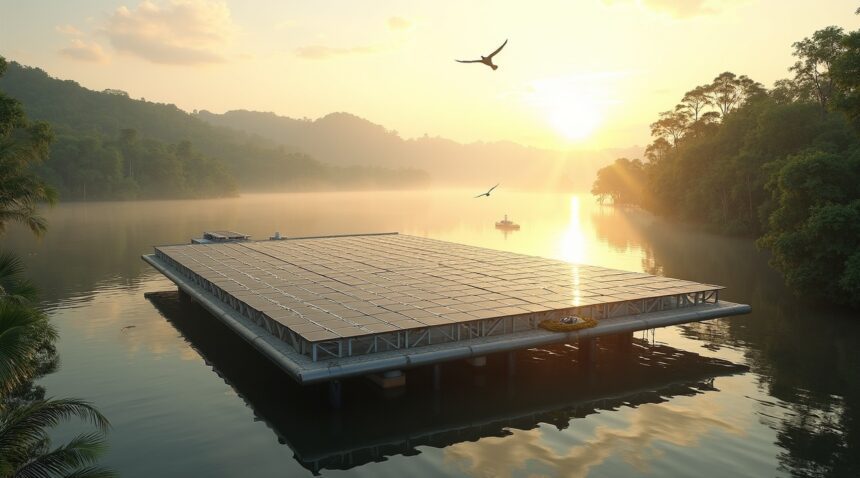Brazil has unveiled a pioneering 350 MW floating solar farm at the Amazon’s Balbina reservoir, signaling a major milestone in sustainable energy and environmental preservation.
Key Takeaways
- The floating solar installation delivers 350 MW of capacity at competitive costs of $65-77 per MWh, making it a cost-effective alternative to traditional energy sources.
- The project reduces reservoir water evaporation by up to 50%, all while maintaining the integrity of underwater habitats and keeping the forest ecosystems above the water untouched.
- Engineers incorporated sustainable materials such as bioplastic components and bamboo elements. The modular design adapts fluidly to river currents without disrupting aquatic ecosystems.
- The solar system works in synergy with existing hydroelectric facilities, delivering complementary energy output that strengthens grid stability and manages water usage more effectively.
- Brazil has vast potential for expansion—by covering only 1% of current reservoir surfaces with floating solar technology, the country could generate an additional 38 GW, enough to supply electricity to 41 million homes.
This initiative highlights how innovative renewable energy solutions can align with conservation goals. To learn more about similar developments, visit the official Brazilian government announcement.
https://www.youtube.com/watch?v=qX0jagTz7H4
Brazil Launches 350 MW Floating Solar Project to Power 15,000+ Homes at Amazon’s Balbina Reservoir
Brazil has launched an ambitious floating solar power project at the Balbina hydroelectric plant, transforming the Amazon River into a testing ground for sustainable energy innovation. This groundbreaking initiative represents one of the most significant renewable energy developments in the region, combining solar technology with existing hydroelectric infrastructure in a way that maximizes energy output while minimizing environmental impact.
The Balbina pilot project delivers an impressive 350 MW of installed capacity, positioning it among the largest floating solar installations worldwide. This scale allows the facility to power over 15,000 homes during its initial operational phase, with expansion potential that could serve tens of thousands more households as capacity grows. The project demonstrates how floating solar technology can seamlessly integrate with traditional hydroelectric systems, creating a hybrid renewable energy solution that’s particularly effective in water-rich environments.
Competitive Economics Drive National Expansion Plans
Cost efficiency makes this floating solar farm particularly attractive from both environmental and economic standpoints. Electricity production costs range from $65 to $77 per MWh, making the technology highly competitive with conventional energy sources. These favorable economics have caught the attention of Brazil’s Energy Minister and the Ministry of Mines and Energy, who’ve confirmed that pilot operations are underway and expressed clear intentions to replicate this technology across other hydroelectric reservoirs throughout the country.
The strategic placement at Balbina leverages existing transmission infrastructure while avoiding land use conflicts that often complicate solar farm development. Floating solar panels actually benefit reservoir environments by:
- Reducing water evaporation
- Limiting algae growth
This creates a symbiotic relationship between energy production and water management.
Brazil’s commitment to expanding floating solar technology signals a national shift toward sustainable innovation that could influence renewable energy strategies across Latin America. The success at Balbina establishes a blueprint for integrating solar and hydroelectric systems that other countries with similar geographic advantages might follow. This project proves that large-scale renewable energy development can coexist with sensitive ecosystems when proper technology and planning converge, setting new standards for environmentally conscious energy production in tropical regions.
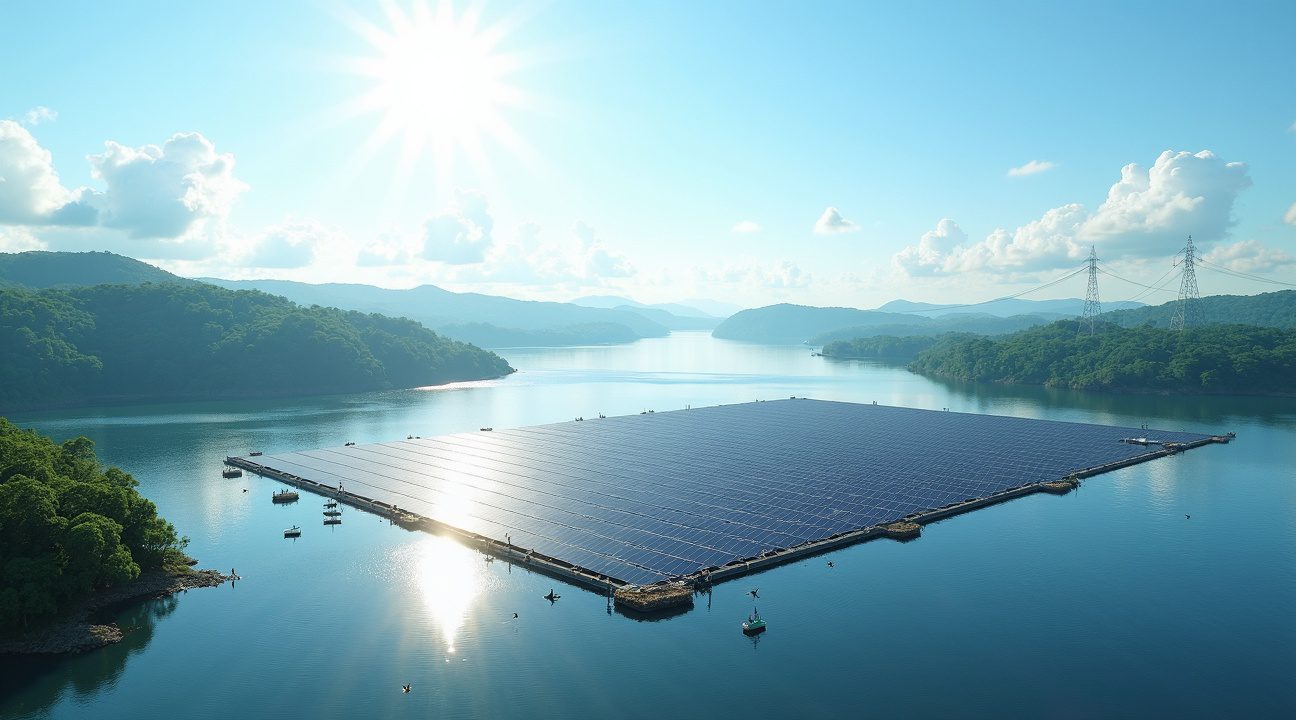
Revolutionary Technology Preserves Amazon Ecosystem While Reducing Water Loss by 50%
The Balbina floating solar project showcases innovative engineering by positioning solar panels directly on the reservoir’s surface, eliminating any need for land clearance in one of Earth’s most critical ecosystems. This approach protects the Amazon rainforest from deforestation while harnessing clean energy, demonstrating how technology can work in harmony with nature rather than against it.
Sustainable Materials and Water Conservation Benefits
Engineers designed the floating PV arrays using bioplastic components, specifically high-density polyethylene (HDPE) floats paired with bamboo elements in certain system configurations. These materials reinforce the project’s commitment to environmental responsibility while maintaining structural integrity in challenging river conditions. I find it particularly impressive that this innovative approach reduces reservoir water evaporation by up to 50%, preserving precious water resources for both hydro turbines and local communities.
The floating panels create a protective barrier over the water surface, significantly decreasing evaporation rates compared to pre-installation measurements. This water conservation effect proves especially valuable in the Amazon region, where maintaining adequate water levels supports both energy generation and ecosystem health. The reduced evaporation also helps stabilize local microclimates, contributing to the broader environmental balance.
Modular Engineering and Zero Environmental Impact
The system’s modular design incorporates strong anchoring mechanisms that respond dynamically to river currents and wind patterns, ensuring stability without disrupting underwater habitats. Each floating platform connects seamlessly with others, creating scalable arrays that can expand based on energy demands while maintaining minimal environmental footprint.
Unlike traditional solar installations that require extensive land preparation, this floating technology preserves existing river ecosystems completely. Fish populations, aquatic vegetation, and water quality remain undisturbed beneath the panels, while the forest canopy above continues its vital role in global climate regulation. The project demonstrates that renewable energy infrastructure doesn’t have to compromise biodiversity or habitat integrity.
Annual evaporation data collected before and after solar deployment confirms the dramatic impact of panel coverage on water retention. This conservation benefit extends beyond immediate energy production, supporting long-term water security for the region. The floating PV system proves that sustainable technology can simultaneously address multiple environmental challenges, from clean energy generation to water conservation and ecosystem preservation, setting a powerful precedent for future renewable energy projects in sensitive ecological areas.
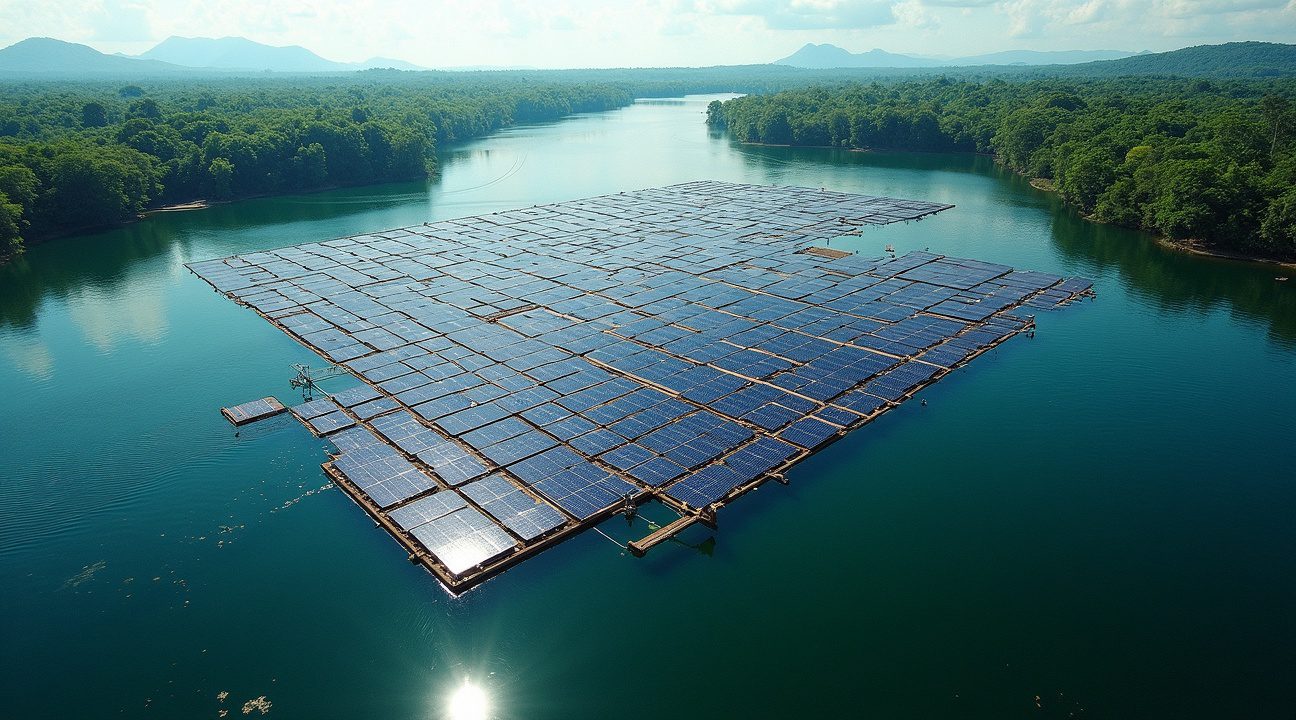
Smart Grid Integration Boosts Efficiency Using Existing Hydropower Infrastructure
I’ve observed how Brazil’s floating solar initiative demonstrates remarkable technical innovation by merging photovoltaic technology with established hydroelectric systems. The Balbina facility creates a powerful synergy by utilizing the existing dam’s operational framework, which allows both energy sources to share critical grid connections and transmission lines.
This strategic approach significantly reduces implementation costs while minimizing environmental disruption. Rather than constructing entirely new infrastructure, the project leverages decades of established hydroelectric operations. The floating solar panels connect directly to Balbina’s existing electrical grid, creating an integrated energy system that maximizes efficiency without requiring additional land clearing or new transmission corridors.
Complementary Energy Generation Creates Grid Stability
The technical brilliance lies in how these two renewable sources complement each other throughout the day. During peak sunlight hours, the floating solar panels deliver maximum output, while the hydroelectric turbines can reduce generation or store water for later use. When solar production decreases during evening hours or cloudy periods, hydropower seamlessly increases output to maintain consistent electricity supply.
This balancing mechanism creates several operational advantages:
- Enhanced grid stability through dual-source generation
- Optimized water reservoir management at the dam
- Reduced strain on individual energy systems
- Improved overall system reliability and performance
Currently generating enough clean energy to power over 15,000 homes, the facility represents just the beginning of Brazil’s ambitious expansion plans. Future capacity upgrades could supply tens of thousands more households through incremental additions of floating solar arrays across the reservoir surface.
The project strategically positions Brazil to diversify its renewable energy portfolio while maintaining cost-effectiveness. By integrating with existing infrastructure rather than building separate systems, the floating solar installation reduces both capital expenditure and ongoing maintenance costs. This approach makes clean energy more affordable for consumers while supporting Brazil’s climate commitments.
Looking ahead, this model demonstrates how countries can accelerate renewable energy adoption by maximizing existing resources rather than starting from scratch. The success at Balbina provides a template for similar projects across Brazil’s extensive network of hydroelectric facilities, potentially transforming the nation’s energy landscape through smart infrastructure integration.
Massive National Potential Could Power 41 Million Homes Across Brazil
Brazil’s floating solar expansion possibilities extend far beyond the initial Amazon installation, presenting extraordinary opportunities for nationwide energy transformation. Research demonstrates that covering just 1% of Brazil’s existing hydroelectric reservoir surfaces with solar panels could generate an additional 38 GW of capacity. This massive potential translates to powering over 41 million homes across the country, representing a significant leap forward in renewable energy infrastructure.
Amazon Communities Embrace Solar-Powered Solutions
Remote Amazon communities have already begun adopting innovative approaches to sustainable energy through solar-powered houseboats. These floating homes serve riverine populations who previously relied heavily on fossil fuels for basic energy needs. These sustainable houseboats transform daily life by providing reliable electricity for lighting, communication, and refrigeration in areas where traditional grid connections remain impossible.
There are several benefits that extend beyond simple power generation, including:
- Enhanced educational opportunities by enabling digital learning tools and extending study hours after sunset.
- Economic growth through access to modern communication technologies and improved logistics.
- Better preservation of goods such as fish and artisan products, increasing their market reach and longevity.
Brazil’s national scaling potential becomes even more compelling when considering environmental protection factors. Unlike conventional hydroelectric expansion that requires damming rivers or fossil fuel plants that generate pollution, floating solar installations preserve natural water flows and maintain ecosystem integrity. Fish populations continue thriving beneath the panels, while water quality remains uncompromised since no chemical pollutants enter the aquatic environment.
The adoption of floating solar technology by Amazon communities provides a valuable testing ground for larger implementations. These real-world applications demonstrate how solar panels can coexist with aquatic ecosystems while delivering substantial local benefits, including:
- Improved health outcomes from reduced diesel generator emissions.
- Enhanced food security through better refrigeration capabilities.
- Increased community resilience in remote areas without access to traditional energy infrastructure.
Brazil’s hydroelectric reservoirs represent an untapped resource for clean energy expansion. This approach offers advantages over land-based solar farms, which compete with agriculture or require forest clearing. Water-based installations reduce evaporation from reservoirs while generating clean electricity, creating a win-win scenario for both energy production and water conservation.
The scale of this opportunity positions Brazil as a potential global leader in floating solar technology, with implications extending well beyond national borders to influence technological innovation worldwide.
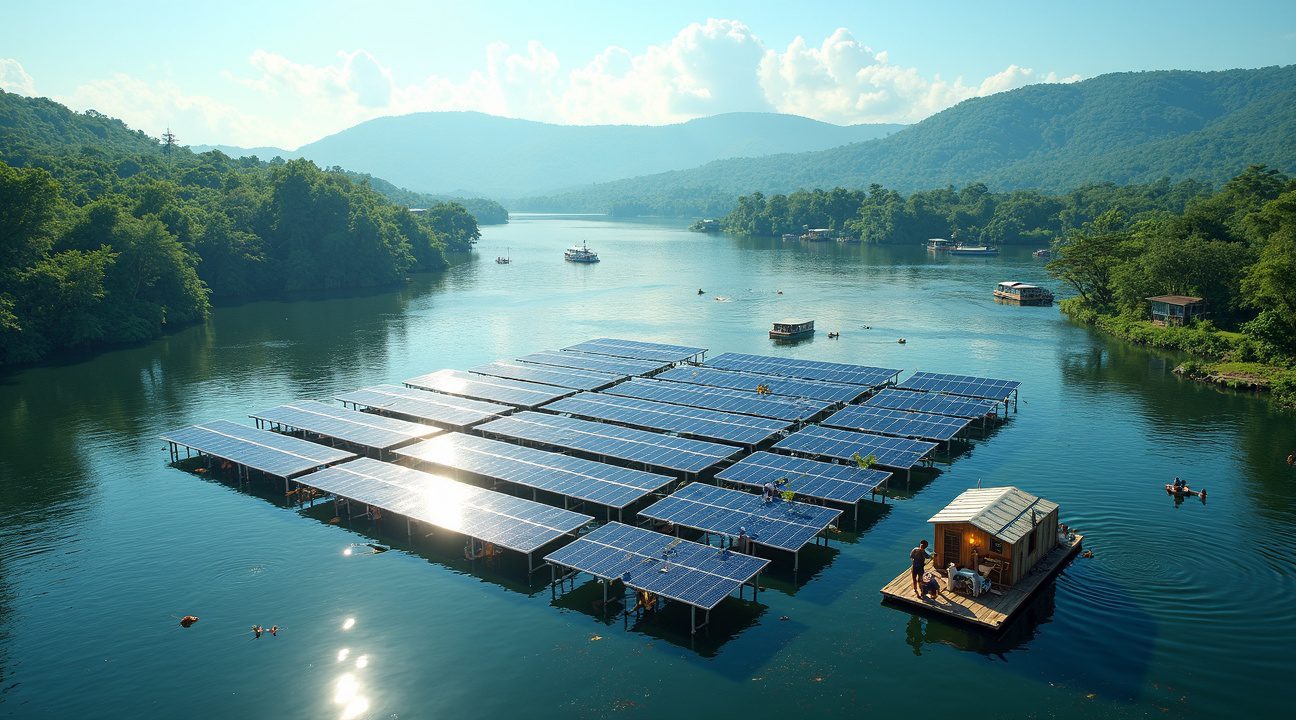
Brazil Leads Latin America’s Green Energy Transition Toward 90% Renewable Target
Brazil stands at the forefront of Latin America’s renewable energy revolution, already achieving an impressive 85% of electricity generation from renewable sources as of 2025. This remarkable milestone positions the country as a regional leader and demonstrates the practical viability of ambitious clean energy goals.
Ambitious Renewable Energy Targets Drive Innovation
The nation has set an even more ambitious target of reaching 90% renewable electricity production by 2030, with floating solar technology playing a crucial role in achieving this goal. This aggressive timeline is both challenging and achievable, given Brazil’s proven track record in renewable energy deployment and favorable natural conditions.
Floating solar installations offer unique advantages that make them particularly valuable for Brazil’s energy landscape. While the levelized cost of energy from floating solar systems remains somewhat higher than traditional land-based installations, the ecological and operational benefits significantly justify the investment difference. These systems prove especially viable in land-scarce regions or ecologically sensitive areas like the Amazon basin, where preserving terrestrial ecosystems takes priority.
Policy Support and Global Competitiveness
National policy frameworks, combined with favorable market conditions and targeted investment incentives, actively support the expansion of floating solar across Brazil. The government’s commitment creates a stable investment environment that attracts both domestic and international funding for renewable projects.
Brazil’s rapid adoption rate in floating solar technology draws interesting comparisons with established global leaders including Japan, India, and Singapore. These countries have successfully scaled similar technologies, providing valuable benchmarks for Brazil’s ambitious expansion plans. It is noteworthy that technological innovation continues to drive down costs while improving efficiency across all these markets.
The long-term economic viability of floating solar becomes increasingly apparent when examining production costs and government energy policies. Background data consistently shows that:
- Operational advantages
- Reduced land requirements
- Improved energy efficiency
offset initial cost premiums. Additionally, floating systems often demonstrate better performance due to the cooling effect of water, which increases panel efficiency compared to land-based installations.
Brazil’s strategic approach to renewable energy expansion serves as a model for other Latin American nations. The combination of abundant water resources, strong policy support, and growing technological expertise positions the country to exceed its 90% renewable target while maintaining economic competitiveness in the global energy market.
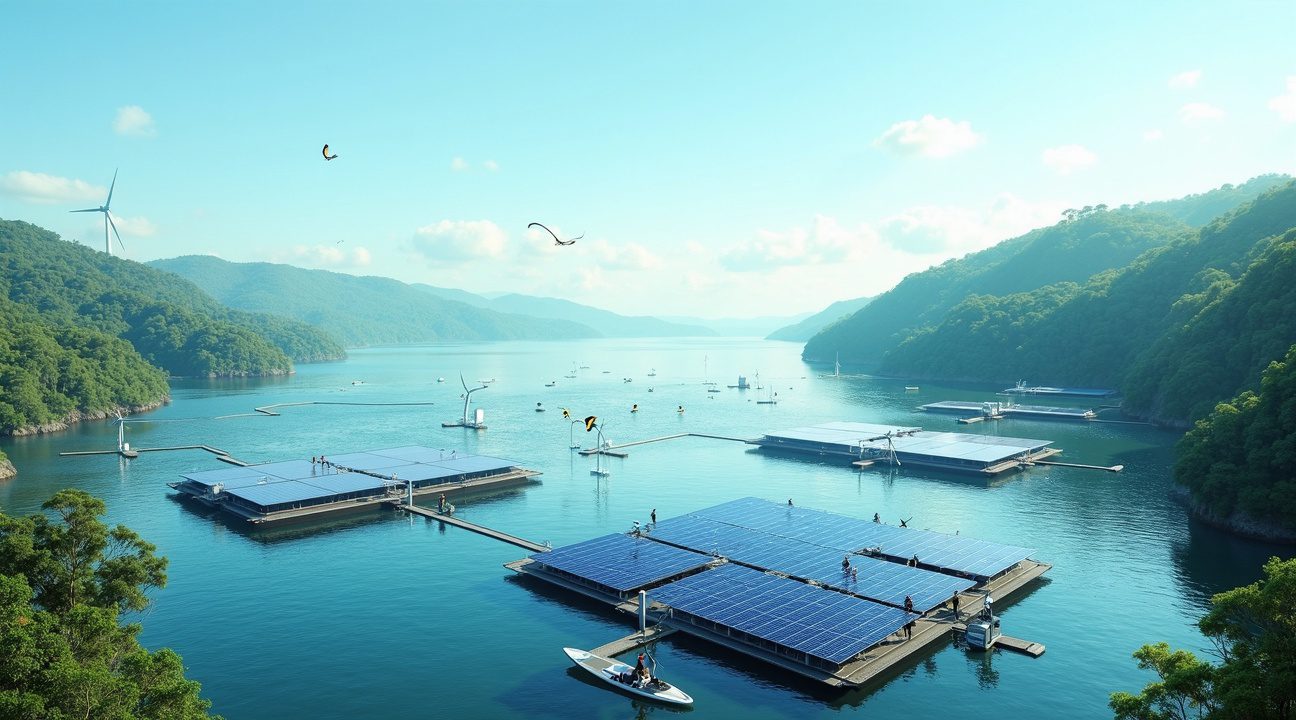
Sources:
PV Magazine – “Floating solar hits $65/MWh LCOE in Brazil with up to 24 GW of potential”
MIT Solve – “Carbon Neutrality Challenge: Enhanced Floating Solar Innovation”
Global Energy Prize – “Enhanced Use of Floating Solar Farms in HPP Reservoirs Proposed in Brazil”
Energy Matters – “350MW floating solar farm for Brazil”
EcoAméricas – “Floating solar farms beginning to gain favor in Brazil”
Revista Pesquisa FAPESP – “Floating Solar Farms”
T&B Petroleum – “Brazil announces huge 350 MW floating solar power plant”
Phys.org – “Brazil dammed lake’s surface for solar farms: Why it’s working”

